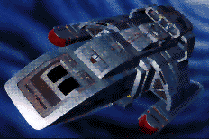
Cutaway of runabout Rio Grande docked at space station Deep Space 9
Image scanned from the Deep Space 9 cutaway poster by Sci Pub Tech. Check out their web page here.

CLASS: Danube Class Runabout
TYPE: Light, short range starship

The Danube class runabout, which has been the mainstay of the runabout fleet for over 40 years now, ressembles a large shuttlecraft. Because of its power output, range, and passenger capacity, it has been officially classified as a starship, and each one has its own registry number, in addition to having names starting with a "USS" prefix. The runabout is made up of three main sections, the cockpit, a central cargo section, and a rear passenger lounge. The cockpit has four positions for the pilot, co-pilot, flight engineer, and weapons officer, in addition to featuring a small, two person transporter. The cargo section is removeable, allowing for mission specific modules to be added to the runabout such as passenger accomodations, cargo pallets, sensor pallets, and even extra weapons systems. The aft section of the runabout is a small lounge, complete with a replicator, a dining table, and bunks for four crew members.
Because the runabout was designed to be stationed at remote outposts, they were equipped with rather decent weapons and shielding for its size. Although a single runabout would have no chance against a small starship, a squadron of three runabouts would make any small marauders turn and run away. Although not as maneuverable as a fighter craft, because of the arrangement of phaser strips in various hardpoints around the runabout this small ship is able to hold its own in a dogfight.
In addition to a standard sensor package similar to those found on the newer Types 8 and 9 shuttlecraft, the Danube class also has a hardpoint on the upper surface of its wings which can be used to attach a heavy sensor pallet. This allows runabouts attached to distant outposts to be able to conduct light scientific missions without having to divert a larger starship to the area.
The Danube class runabout is the only starship which is able to be carried in the shuttlebay of another ship. In recent years, even small destroyers such as the Feynman class of starships has taken advantage of this feature. Larger starships, such as the Galaxy class and its derivatives, are able to carry up to three runabouts in their cavernous main shuttlebay. With large ships, the runabouts augment the already sizeable shuttle wings, usually being used as command ships for the wing commanders in addition to rescue craft. In the smaller ships, such as the Feynman class, the runabout is used as a primary means of long range transportation when the mothership is either not needed or is needed elsewhere. Onboard the USS Feynmen herself, the runabout, along with the other shuttles assigned to her, have been modified to allow them to augment the explorer's DELPHI sensor array.
Like shuttlecraft, the runabouts that are attached to starships and outposts are named by the commander, and many use their own naming tradition for that. Captain Benjamin Sisko used to name the runabouts assigned to Deep Space 9 after Terran rivers. The USS Feynman names their runabouts after admirals whose names begin with an "N".


USS Nechayev without the sensor pod. The Nechayev is currently attached to the USS Feynman
Image scanned from the Star Trek Encyclopedia by Michael Okuda